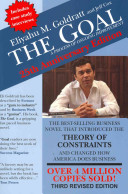

The Theory of Constraints (TOC) is a central concept in 'The Goal' that emphasizes the importance of identifying and managing the bottlenecks in a production process. The premise is that every system has at least one constraint that limits its performance relative to its goal. In a manufacturing context, this could be a machine, a worker, or an operational process that slows down production. By focusing on and improving the constraint, organizations can achieve significant improvements in throughput, efficiency, and overall performance. The process involves five steps: identifying the constraint, exploiting the constraint to maximize its output, subordinating other processes to the needs of the constraint, elevating the constraint to increase its capacity, and repeating the process as new constraints emerge. This cyclical approach encourages continuous improvement and helps organizations adapt to changing circumstances, ensuring sustained growth and efficiency over time.
Continue readingThe book emphasizes the importance of having a clear and shared goal within an organization. In 'The Goal', the protagonist, Alex Rogo, learns that the primary goal of any manufacturing organization should be to make money. This overarching goal must guide all decisions and processes within the company. When employees understand the organization's goal, they can align their actions and decisions accordingly, leading to more cohesive teamwork and improved performance. Goal alignment also involves recognizing that different departments may have their own objectives, but these should ultimately support the organization's primary goal. By fostering a culture of goal alignment, organizations can improve communication, reduce conflicts, and enhance overall productivity.
Continue readingA key takeaway from 'The Goal' is the relationship between throughput, inventory, and operating expense. Throughput refers to the rate at which a system generates money through sales, inventory is the money tied up in unsold goods, and operating expense is the money spent to convert inventory into throughput. The book illustrates that the primary focus of any organization should be on maximizing throughput while minimizing both inventory and operating expenses. By optimizing these three elements, companies can increase profitability and ensure long-term sustainability. Understanding this relationship allows managers to make informed decisions that enhance operational efficiency and drive financial success.
Continue readingContinuous improvement is a recurring theme in 'The Goal', highlighting the need for organizations to constantly seek ways to enhance their processes and performance. The journey of improvement is never complete; as one constraint is resolved, another will emerge. The book encourages a mindset of ongoing assessment and adaptation, where teams regularly analyze their workflows, identify inefficiencies, and implement solutions. This could involve adopting new technologies, refining processes, or investing in employee training. By fostering a culture of continuous improvement, organizations can remain competitive in a rapidly changing market and ensure they are always moving toward their goals.
Continue readingLeadership plays a crucial role in driving the success of an organization, as illustrated in 'The Goal'. The protagonist, Alex Rogo, learns that effective leadership involves not only setting clear goals and expectations but also inspiring and empowering employees to take ownership of their work. Good leaders create an environment where team members feel valued and motivated to contribute to the organization's success. They also facilitate open communication, encourage collaboration, and support professional development. By prioritizing leadership development, organizations can cultivate a strong workforce that is aligned with the company's goals and committed to achieving them.
Continue readingIn 'The Goal', the importance of cross-functional collaboration is emphasized as a means to achieve organizational objectives. Different departments often operate in silos, leading to inefficiencies and miscommunication. The book illustrates how fostering collaboration between departments, such as production, sales, and finance, can lead to better decision-making and improved outcomes. By breaking down barriers and encouraging teams to work together towards common goals, organizations can enhance their problem-solving capabilities and drive innovation. Cross-functional collaboration also helps to align efforts across the organization, ensuring that everyone is working towards the same objectives.
Continue readingOne of the standout features of 'The Goal' is its practical approach to applying theoretical concepts in the real world. The narrative follows Alex Rogo as he navigates the challenges of improving his plant's performance, illustrating how the Theory of Constraints can be implemented in a tangible way. The book provides readers with actionable insights and frameworks that can be applied to their own organizations, making it a valuable resource for managers and leaders. By demonstrating the real-life implications of the concepts discussed, 'The Goal' bridges the gap between theory and practice, empowering readers to take meaningful steps towards improvement.
Continue reading